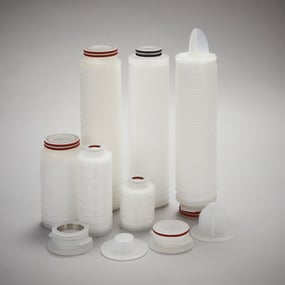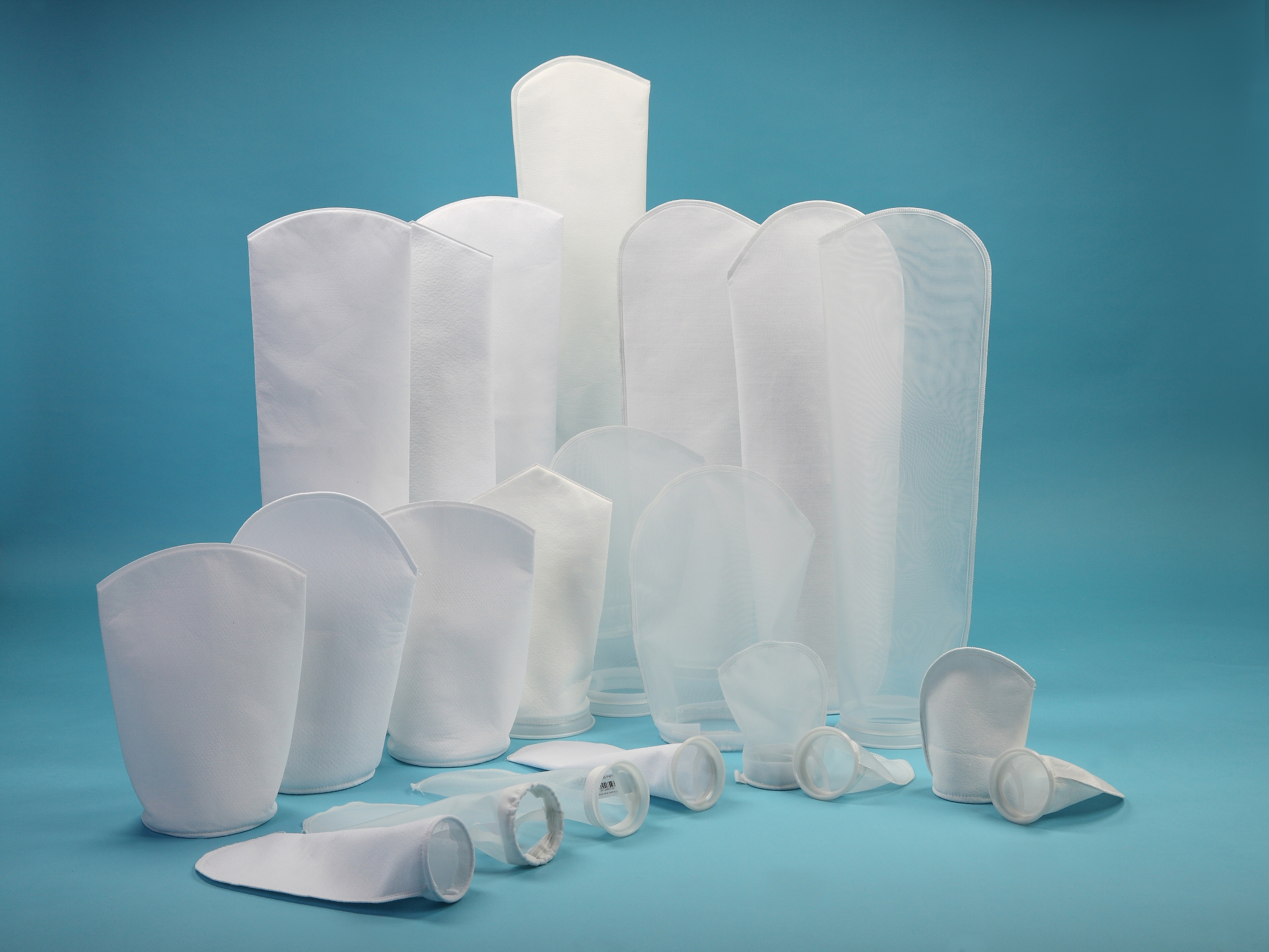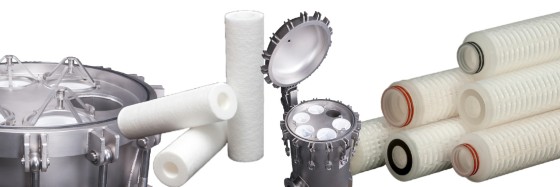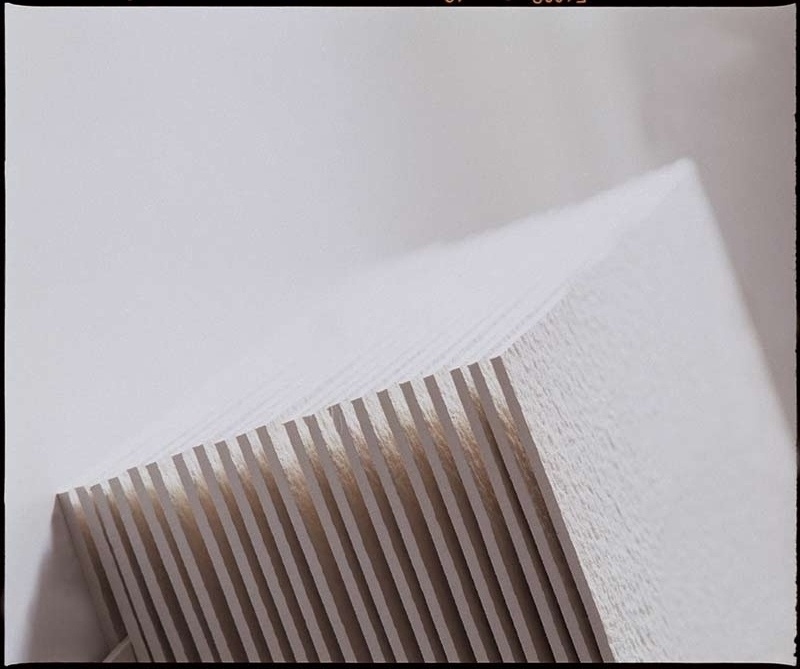Membrane Cartridge Filters & Serile or Final Filtration.
Membrane cartridge filters play a key role in sterile filtration or bioburden reduction of bacteria, microorganisms, phage, etc, from liquids and gases.
They are available in a range of different formats to enable desired flow rates to be handled – disposable (ml/min), capsule (100ml/min), junior (1-3 lt/min), cartridge (10-20 lt/min) and finally multi cartridge (m3/hr).
Securely removing microorganisms
The microporous membranes used in these cartridge filters are typically composed of a thin (100 microns), porous material that can be made from various polymers, ceramics, or metals. The key feature of these membranes is their porosity, with countless microscopic pores or openings distributed throughout the material.
One of the critical aspects of microporous membranes is that pore size can be controlled with a high degree of precision. This allows the selection of a membrane with the appropriate pore size for a specific microfiltration application. The most common micron ratings are – in gases 0.02 – Phage and virus removal, and in liquids 0.1 – Mycoplasma removal, 0.2 – Bacteria and microorganism, 0.45 – Spoilage organisms and bioburden reduction, 0.65 – Spore and larger spoilage organisms.
Hydrophilic or Hydrophobic?
Membranes are either hydrophilic or hydrophobic in nature. This means either water liking or water disliking and this therefore determines the types of liquid that they are used for. Polar liquids (aqueous solutions) use hydrophilic membranes because they are easily wetted for effective filtration - PES, Nylon and Cellulose. And non-polar (solvents and chemicals) use hydrophobic membranes - PTFE and PVDF - due to their greater chemical compatibility.
Symmetrical or Asymmetrical?
Another aspect of membrane cartridge filters to consider is whether a symmetrical or asymmetrical membrane structure is most appropriate. Membrane filters with a symmetrical structure have a uniform pore size distribution throughout the membrane material. The structure of the pores is consistent, resulting in even filtration across the entire surface area. They work well for applications where precise particle removal is necessary..
Membrane filters with an asymmetrical structure have varying pore sizes throughout the depth of the membrane structure. They are designed intentionally with a reducing gradient in pore size from the upstream to the downstream surface of the membrane. The gradient structure allows larger particles to be trapped on the outer surface, while smaller particles are captured deeper within the membrane. This offers the benefit of higher flowrates or longer service life.
Cartridge filters using symmetrical membrane structures are used in applications requiring high precision filtration, such as pharmaceuticals, fine chemical production, and certain water purification processes, whereas asymmetrical membrane structures are used in continuous (24x7) applications and pre-filtration for symmetrical membranes.
Available Membranes
There are 5 common membranes in use in the process industries today – PES, PVDF, PTFE, Nylon, Cellulose.
PES (Polyethersulphone) Membrane Cartridge Filters: 
PES membrane cartridges have become the predominant product used in liquid filtration applications since its introduction in the late 90s because of its high flow rates, consistent wettability and ease of manufacture. Additionally, it has low protein binding characteristics and good chemical compatibility. It is used in a wide spectrum of applications from biopharmaceuticals, pharmaceuticals, food & beverage, process and ultrapure water applications.
PTFE (Polytetrafluoroethylene) Membrane Cartridge Filters:
PTFE has both excellent chemical resistance and high temperature stability. PTFE membrane, unlike other membranes, is not produced by a casting process, but by a controlled stretching process. Due to this its' voids volume, a measure of the free volume within the membrane structure, is 80% (4:1) rather than 66% (2:1). Its flow rates are twice that of the cast membranes, however it is one of the most expensive membranes and this limits its use compared to PES.
Used in aggressive chemical applications within semiconductor and API manufacture and is the predominant membrane used in sterile gas filtration due to its superior flow performance.
PVDF (Polyvinylidene Fluoride) Membrane Cartridge Filters:
PVDF membrane key characteristics are broad chemical resistance to aggressive solvents and chemicals, broad temperature compatibility, and extremely low protein binding characteristics. Therefore, it finds broad application in chemicals, electronics, biologicals and vaccines and has also found application in gas filtration, due to it being hydrophobic, but has significantly worse flow rates than PTFE.
Nylon Membrane Cartridge Filters:
The workhorse of membrane filters during the late 70s, 80s and 90s until it was replaced by PES. A durable and strong membrane that gave consistency in filtration performance and wettability in application compared to all other products available during that period. Now mostly replaced, but are sometimes still found in existing validated processes where the cost of changing to another membrane type is high.
Cellulose Membrane Cartridge Filters:
The very first membrane to be commercially produced, late 50s/early 60s, in a cartridge format. Available in both asymmetric and symmetric membrane pore structures, it offered a cost effective membrane and broad chemical compatibility. However, its consistency in wetting out and extractables were downsides, and although used extensively initially, it was quickly superseded by nylon when that was introduced.
It has found application in niche segments of water treatment and pharmaceuticals due to having asymmetrical structure options. Today this is a legacy product if used.
In Closing
Membranes are used to provide that final guarantee of liquid or gas cleanliness and there is a wide variety available to allow suitable selections to be made for most applications. Here at PorefilterUK Ltd we can over all the main membrane cartridge filters in a range of formats and end caps types so that we can offer to new applications combined with one of our housings, or as a retrofit option in an existing application. Send your enquiry to enquires@porefilter.co.uk and we will get back to you straight away,
PoreFiltration – Making your filtration systems work harder





